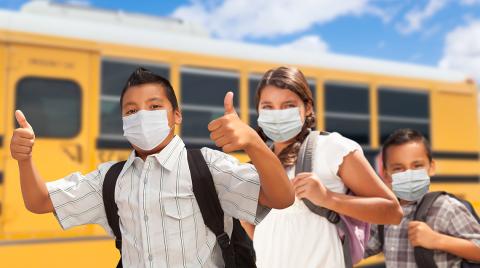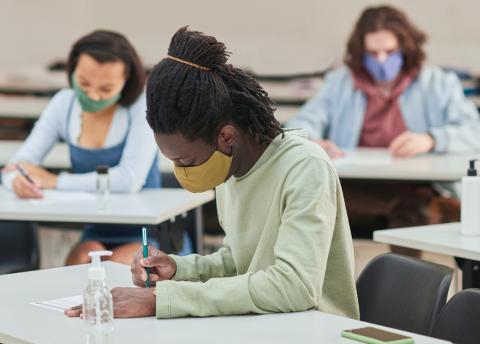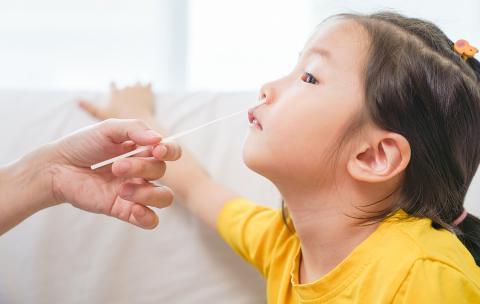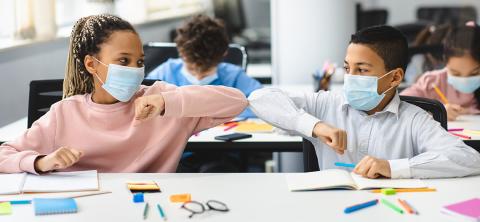Put to the Test
Agencies, Researchers Plan for Safe In-Person School

Photo: Andy Dean Photography/Shutterstock
Parents across the country are sending their children back to classrooms, likely with a mix of excitement and apprehension, as the coronavirus pandemic rages on. Even in areas better protected by higher vaccination rates, children younger than 12 are not yet eligible to get immunized. The situation is compounded by the more virulent Delta variant that’s increasingly infecting kids and some vaccinated adults.
Getting students and school staff safely back to an in-person environment requires ongoing surveillance and mitigation strategies, an even greater challenge for communities hardest hit by the pandemic.
Earlier this year, NIH launched a Safe Return to School Diagnostic Testing Initiative, part of Rapid Acceleration of Diagnostics-Underrepresented Populations (RADx-UP). The initiative is a series of projects designed to scale up Covid testing in vulnerable, underserved communities that have been afflicted by disproportionately high infection and mortality rates, and to analyze data toward reducing these disparities.
“This is the largest single disparities-related project NIH has ever funded,” said NIMHD director Dr. Eliseo Pérez-Stable of the $500 million RADx-UP.

Photo: SEVENTYFOUR/SHUTTERSTOCK
The Return to School component so far has invested more than $50 million to fund projects at 16 institutions across the country to build evidence on the efficacy of sustained Covid-testing and other mitigation efforts in schools. The projects focus on vulnerable populations including racial and ethnic minorities, underserved rural communities, people of low socioeconomic status and children with medical complexities—from Los Angeles to Miami, from Lincoln, Neb., to Baltimore.
On Aug. 9, partnering agencies and investigators shared ideas and plans for return-to-school projects during an NICHD-led virtual workshop. Several HHS and CDC program leads discussed nationwide testing efforts working directly with schools, health departments, laboratories and pharmacies.
HHS has made significant investments “to ramp up screening and testing to help schools reopen and keep them open,” said Angelica O’Connor, CDC’s program coordinator for Epidemiology and Laboratory Capacity for the Prevention and Control of Emerging Infectious Diseases (ELC).
O’Connor noted that the $10 billion from HHS, granted via the ELC Reopening Schools award, provides schools with critical resources to implement testing and prevention measures as they institute other pandemic safety protocols.

ELC-funded health departments will work with school districts to boost screening and diagnostic testing in K-12 schools and fund prevention and mitigation efforts such as personal protective equipment and portable high-efficiency particulate air filters through the current school year.
“The biggest focus moving forward is going to be continuing to work with our jurisdictions,” said O’Connor. “Some jurisdictions have lacked parent or community buy-in for screening, although we may see that shift a bit now with [concern over] the Delta variant.”
Another HHS-funded initiative, Operation Expanded Testing, is a $650 million public-private partnership with laboratories to provide no-cost Covid testing to K-12 schools and underserved settings such as shelters. Three companies serve as hubs to cover the entirety of the United States. So far, about 1,000 sites are enrolled and the program is rapidly expanding.

Photo: CHATCHAI.WA/SHUTTERSTOCK
With the anticipated additional enrollment of more than 2,000 schools, “we’re expecting by mid-September 1.5 million tests total per week being conducted in the program,” said Dr. Matthew Humbard of HHS’s testing and diagnostics work group.
Further expanding national testing capacity, the Increasing Community Access to Testing in Schools (ICATT) has partnerships with pharmacy chains to facilitate school screenings.
Implementing this program requires “having a really clear plan for how testing is going to be executed and not just testing but what you’re going to do when you get a positive test,” said Dr. Joseph Miller, ICATT program lead. “[We’re] also making sure [schools] are partnering with their local public health department to ensure consistency between the schools…[Also key is] early communication between school staff and leaders and making sure you’re getting very, very quick results back to parents and schools.”
Back to School
What We’re Learning So Far
Since launching its Safe Return to School Diagnostic Testing Initiative in April, NIH has released some initial findings from its studies across the country:
- Testing in schools is feasible and can be implemented with strong, continuing community and school support, engagement and outreach.
- Low positivity rates and low secondary transmission can be achieved in schools when mitigation strategies are in place.
- Asymptomatic testing uptake by parents is challenging due to misconceptions about tests and/or Covid-19, distrust in Covid test results, concerns about quarantining and the perception of low risk due to other mitigation strategies at school.
- Access to testing after possible Covid-19 exposure is associated with increased uptake.
- It is important to disseminate information and results, provide access to the science and scientists, and rapidly respond to community requests for support.
- It’s still unknown what impact increases in other respiratory viruses, as well as the virulent Covid-19 Delta variant will have on return to school. —Dr. Alison Cernich, NICHD deputy director
During the workshop, Dr. Shamez Ladhani, a pediatric infectious diseases consultant at St. George’s University in England, shared insights from the U.K., where in-person school resumed a year ago and schools have remained open even during successive national lockdowns.

However, he contends, schools are not hubs of infection. “The evidence for in-school transmission—given all the mitigations in place, however well they’re being done and managed given the circumstances—is sufficient to maintain an infection rate that’s at least no higher than the community infection rates, and generally lower.”
In the U.K., Covid outbreak risks have varied. In primary schools, Covid more commonly inflicts staff; in secondary schools, students are more likely to be infected.
“What’s really interesting is the attack rate between students has remained very, very low, between 0.8 and 1.2 percent in primary and secondary schools,” said Ladhani, “and this compares to almost 10-fold higher attack rates in primary schools and 4-fold higher attack rates in secondary schools [among staff].”
One U.K. study last year collected blood samples from 3,000 staff and students at nearly 50 primary schools across England over 6 months. In December, after a full term of in-person schooling, about 5 percent of staff and students went from being antibody negative at the start of the surveillance to antibody positive by December 2020, indicating that only a small proportion of students and staff developed symptomatic or asymptomatic infections despite full in-person teaching. Secondary schools had a higher antibody-positivity rate but nowhere near the community rate at the time.
“If [schools] were genuinely hubs of infection,” said Ladhani, “we would’ve expected 4- or 5-times higher antibody rates after in-person teaching for 12 weeks.”
What’s more, the latest data offers good news about antibody protection in children.

Photo: PROSTOCK STUDIO/SHUTTERSTOCK
“What we’re finding now is that 6 months after infection, the antibody persistence in children appears to be as good as, if not better than, in adults,” likely persisting for at least 12 months, he said. Children “do seem to develop very robust antibody responses even after asymptomatic infection.”
But in January, another national lockdown closed U.K. schools for 2 months, as the more contagious Alpha variant wreaked havoc. Ladhani noted a small infection peak among 10- to 19-year-olds when schools fully reopened, despite mandatory testing of all secondary students before they returned. However, there was no increase in hospitalization or ICU admissions in that age group.
Experts continue to urge vaccinating all who are eligible because worldwide evidence shows that immunizing adults protects children.
“If we can control community infection rates,” Ladhani said, “we probably will be able to do a better job of controlling infections in schools.”
